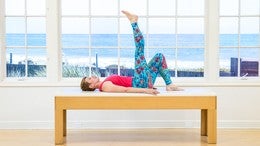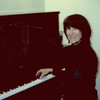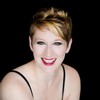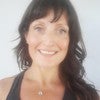Description
About This Video
Transcript
Read Full Transcript
Today we're going to explore something that I call a movement mantra. This is a series of movements that is enjoyable, it's nourishing, and it can be practiced regularly. It's something that you can do in addition to your plot is practice does not take the place of your is practice, but rather it can enhance your [inaudible] practice by providing a vehicle from which to gain some information about your body. It's something that I do pretty much every day to wake myself up and it's something that I asked my clients to do on the regular because they can't always remember what we do in our sessions. So let's begin. It's very simple and it's just involves having fun and getting in touch with our body.
So we're going to begin with a big arm circle imagining that maybe you just moved out of your bed, maybe you just woke up, you've taken a couple of breaths in and out and you're ready to get your body prepared for its next endeavor for eating. And then we'll reverse. Really and truly the intention behind all of these movements is just discovery, just awakening, circulation, discovery. What's moving for me and what's not. Let's take a deep breath in looking to see where the breath travels. Brass out. I'm not worrying about my shoulders and just moving my body. I'm in a nice stable stance.
I'm not worrying about balance. An exhale, and then we're going to reach up and start to think about catching a falling star. So adding an element of fun into our movement will hopefully engage our brain in a different way from what to choose to being engaged. So we're catching with our hands. You're using your fingertips. We're starting to warm up our risks for the full day of phone and computer fun and just starting to sway the body, reaching up out of the hips, pulling up and out of the waist and seeing what's available. Maybe if there's even a little bit of rotation available for you, good. One more, and then we'll reach both arms up and just let them fall down in between each little movement and I say, okay, how are things? Things seem pretty good.
Let's move on. We're going to go outside to the outer edges of my arches inside to the inner edges of the arches of the feet. I'm just starting to pretend like possibly I might be in some sand and that I can feel the shape of the bottom of my foot and I can also feel my weight dropping deeper down through my hips, down through my thighs, into my foot so that the foot itself can almost become wider on the floor. We'll do one more out and one more in gained a little bit of information about this left leg. So I'm going to be really careful in the sense where I'm putting a little more attention as we start to move through the next few movements.
Now we're going to start to just walk in sand and the intention of this walking pattern is to actually press weight down versus the pic weight up. So again, I'm trying to explore noticing that this ankle is a little flow. So maybe I'll take a little more time as I'm moving through the ranges of motion. Just simply going side to side at first and maybe I'll discover play with what happens when I move my legs a little closer together when I bend my knees a little more and then also possibly what happens as a move my legs a little farther apart and shift my weight a little more and then I can start to think about making these footprints in a few different positions. I'm kind of watching, looking on the floor when you think about it.
We're going to be moving throughout our day on our feet and not many of us take the time or have the time to start to think about what that might feel like. We don't prepare our foot for the shoe necessarily and this is just a nice way. Put some music on to go back and forth and then has become kind of back into center that feels, I usually say do it until you feel like it's done and then we're going to start to just pick the knee up and do a little marching. So nice and easy. You can always reach your arms out to the side as you do it. And I often times say to clients in, as you're doing these movements, do it in a way that solicits a smile on your face.
So this is not a chore but it's something that actually feels good. It's like you want to do it cause you remember what might happen after you complete and usually that's you feel really ready for the day. And then from here we'll start to pull our knees up a little bit more. Adding just a little element of balance side to side kind of looks like a plot exercise you might do later on in life or the day side to side. Good.
And from here we're going to just start to take our selves out a little farther and we're going to start to just do a little sway side to side out and in. And in this little challenge of weight shifting, we begin to just bring our hips into play. Begin to think about what it might be like to move laterally, what it might be like to bear weight on one foot versus the other. And then maybe we can even take it into a little fun speed skater. I have a little hallway at home that I do as in, it's not very wide, but it's wide enough to just get the blood flowing and move the legs and arms.
And after all I'm just checking in. Everything counts in movement, but this doesn't mean that it's so significant that it has to be perfect. It's just moving in your body. Good. We'll come back to center and then we're going to practice a hip hinge. So a little soft knee allowing our weight to drop down and just starting to fold forward at the hips and come back up. So ideally had entail her in one nice long line and coming back up, we're trying to see where does the weight shift.
Is this a comfortable mechanic for us to participate in? Are the hamstrings getting happier as we start to bend forward and back? Is it possible to feel more of a deep hip fault because we've just gotten out of bed, but we haven't necessarily gotten down to the floor yet, which is what we're about to do next. So from here, we'll then forward, we'll bend the knees until we can get down and then come up onto the knees, bend forward, stand up and come all the way up, hinge forward, hands down and you can do any variation hopefully on the next few moving to where you might not even need the hands to stand up. So hinge
And this is most well known as a cat cow, but it's also what I like to call a body yawn. So rather than making a shape, let's just allow the chest and the tail to reach an opposition of each other and then allow them to reconnect through the center and stretching and then pulling in this exercise you can gain so much information about your spine and where it's mobilizing or not and also maybe where you might have to work a little bit later in your movement practice. One more time reaching up and all the way back and then we're going to sit back and just take a deep hip fold sway side to side. And we're going to begin to sweep the floor. It works a little better. If we open the knees side to side, we're just going to bring the body over to the right and then we're going to bring the body over to the left. And again, moving in a range that feels nourishing, that's enjoyable, doesn't cause pain. I want to do a couple more like this.
I like to think about it as sending an invitation to the body and seeing who sends back an RSVP will come to center. That'll come all the way up. No, we're going to come to a seated position. So from here we'll go into a little bit of lateral flection again, just to satisfy that range of motion. So I call this a little secret side bend. Basically going to be taking the head over as if someone's telling you a secret, like small beetle on the floor and you're just going to reach and see if you can like, it's a good secret. So you want to hear a little bit more about what they're talking about. It's like juicy gossip.
So we'd go over as far as we can and then we simply come back up and then we go again to the other side. What are they saying? Seeing how far you can take it, and then we come back up in general because I teach so many breathing patterns throughout the day, I try to keep my breath natural fluid, trying not to hold it or force it. I'm trusting that my body will support itself in these simple movements and that my brain while remember, remember hopefully the the preference, the preferred way to go about doing that. Good. From here I'm going to take the hands on the knees and we're going to go rounding the body forward. So head is towards the heel and we're going to do a little bit of neck articulation by looking up first and then following with the chest all the way up and back and then rolling the hips under.
Looking down at the belly, rounding over, this is like your turtle shell looking up, reaching up, taking your spine along and really using your iFocus to change the directions of your body. Kind of a body wave. But we want to see if we can get some of those neck extensors to lead us into full extension. Working the Mac on purpose for moving the neck on purpose is a challenge these days with all of our postural patternings and we'll do one more here. Rounding forward, looking up, oh the way to the ceiling and then coming back to center and I'm going to go down on our backs for a moment. And so this revisits the knee folding, simply pulling in, deepening the hip folds and releasing, getting a little hip pop. They're defunding the hip fold and releasing.
And so it's just nice to do this a few times and then we can maybe challenge the core a little bit more by going side to side. I find with some of my older clientele, this is just a nice simple beginning of the day or good mid day reset for their hips, reminds them what they're available to do and gives them a place to be. From here, we'll lower down, we're gonna take the arms up and rather than making this a technical rib cage, arms exercise, let's think about it as another yon so we can actually yawn. It's okay. And we're going to send the legs out as the arms reach overhead and think about length versus arching our back. When you get to the end, stretch a little more through the sides. I'm not necessarily holding my belly taut per se, just more trying to lengthen as much as possible. And then from here, take a breath in. Exhale, pull everything back to center.
And I'm probably gonna Yon on this so you can [inaudible] with me. So we're breathing in and that's just kind of nice to let yourself beyond. I was in ballet, we didn't get too young. We would have to, we would be kicked out if we [inaudible]. Okay. One more [inaudible] overhead rover. We're waking the body up and then bringing it all the way back in.
And then from here we're going to go ahead and roll over onto the belly. So we've done a lot of kind of pre work, but this is also good warm warmup work. So from here we're just going to take the head down and this is more of an exercise of flight, meaning I'm just hovering than it is a full back bend. So we start to just hover the hands off and we start to pull the wings down the back and then we start to see if we can just have her up and take the arms out to the side. And then it's like we're a bird or an airplane in flight keeping our legs, it's long.
Our backs reaching and slowly just rolling over onto one side, maybe even taking the focus up to the other side, slowly rolling back to center and then slowly rolling. I think they call it pitch. And Ya think I am not a pilot reaching one side and on just waking up some of those deep back extensors and rotators and then we can come back down and we'll do that one more time. It's a rolling the shoulders down and back. Taking the hands just off Hubbard, lifting up, feeling the length from head to tail, reaching the arms out wider than we did the last time and then we'll roll the other direction. This way is stretching and reaching, trying to keep one arm up as the other one goes and yet if the mood hits you, perhaps you might feel like you can get a little more support by putting one arm down and everything being in the name of exploration and discovery. That feels pretty good.
Last one and then we come all the way down. We'll come back onto the knees and we'll come back all the way up into the knees and hopefully all of our systems are together enough to where we can just stand up tall. Glad that worked out and then we'll just finish up with a couple of deep breaths. Big Arm circles. Inhale and exhale. So this is something you can give to your clients. You can give to yourself. If you're an enthusiast, you can definitely, if you're a human being, you can also do this in reach in the opposite direction.
Checking in with your breath at the beginning of the end of the sessions is always a really good thing. Expanding and re recognizing that when we move all our bodies together, when we check in with all of the pieces that we come together as a whole and we are better equipped to do our day.
Comments
You need to be a subscriber to post a comment.
Please Log In or Create an Account to start your free trial.















